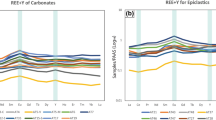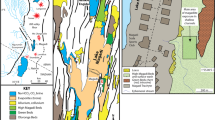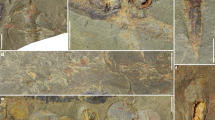Abstract
Microbialites, including biogenic stromatolites, thrombolites and dendrolites, were formed by various microbial mats that trapped and bound sediments or formed the locus of mineral precipitation1. Microbialites were common and diverse during the Proterozoic2,3,4, but declined in abundance and morphological diversity when multicellular life diversified during the Cambrian Radiation. A second decline occurred during the Ordovician Radiation of marine animals, and from then until the present microbialites have been confined largely to high-stress environments where multicellular organisms are rare. The microbialite declines in the Phanerozoic are attributed to disruption of the mats by animals2,5,6. A resurgence of stromatolite abundance and size during reduced animal diversity after the Permian extinction7 has been documented anecdotally. Here we show, with statistical support, that a microbialite resurgence also occurred after the Late Ordovician extinction event in western North America. The resurgences were associated with loss of mat-inhibiting animals, providing insights into shallow-water community structures after extinction events.
This is a preview of subscription content, access via your institution
Access options
Subscribe to this journal
Receive 51 print issues and online access
$199.00 per year
only $3.90 per issue
Buy this article
- Purchase on Springer Link
- Instant access to full article PDF
Prices may be subject to local taxes which are calculated during checkout



Similar content being viewed by others
References
Riding, R. Microbial carbonates: the geological record of calcified bacterial–algal mats and biofilms. Sedimentology 47(Suppl. 1), 179–214 (2000)
Awramik, S. M. Precambrian columnar stromatolite diversity: reflection of metazoan appearance. Science 216, 171–173 (1982)
Awramik, S. M. & Sprinkle, J. Proterozoic stromatolites: the first marine evolutionary biota. Hist. Biol. 13, 241–253 (1999)
Grotzinger, J. P. & Knoll, A. H. Stromatolites in Precambrian carbonates: evolutionary mileposts or environmental dipsticks? Ann. Rev. Earth Planet. Sci. 27, 313–358 (1999)
Garrett, P. Phanerozoic stromatolites: noncompetitive ecologic restriction by grazing and burrowing animals. Science 169, 171–173 (1970)
Walter, M. R. & Heys, G. R. Links between the rise of Metazoa and the decline of stromatolites. Precambr. Res. 29, 149–174 (1985)
Schubert, J. K. & Bottjer, D. J. Aftermath of the Permian–Triassic mass extinction event: paleoecology of Lower Triassic carbonates in the western USA. Palaeogeogr. Palaeoclimatol. Palaeoecol. 116, 1–39 (1995)
Harris, M. T. & Sheehan, P. M. in Paleozoic Sequence Stratigraphy: Views from the North American Craton Special Paper 306 (eds Witzke, B. J., Ludvigson, G. A. & Day, J. E.) 161–176 (Geol. Soc. Am., Boulder, CO, 1996)
Harris, M. T. & Sheehan, P. M. in Silurian Cycles: Linking Dynamic Stratigraphy with Atmospheric and Oceanic Changes Bulletin 491 (eds Landing, E. & Johnson, M. E.) 51–61 (New York State Museum, Albany, NY, 1998)
Sheehan, P. M. The Late Ordovician mass extinction. Ann. Rev. Earth Planet. Sci. 29, 331–364 (2001)
Sheehan, P. M. & Harris, M. T. in Early Paleozoic Biochronology of the Great Basin, Western United States Professional Paper 1579C (ed. Taylor, M. E.) 85–115 (US Geol. Surv., Washington DC, 1997)
Raup, D. M. & Sepkoski, J. J. Jr Mass extinctions in the marine fossil record. Science 215, 1501–1503 (1982)
Brenchley, P. J. et al. Bathymetric and isotopic evidence for a short-lived Late Ordovician glaciation in a greenhouse period. Geology 22, 295–298 (1994)
Siegel, S. Nonparametric Statistics for the Behavioral Sciences (McGraw-Hill, New York, 1956)
Sepkoski, J. J. Jr Biodiversity: past, present, and future. J. Paleontol. 71, 533–539 (1997)
Bottjer, D. J., Droser, M. L., Sheehan, P. M. & McGhee, G. R. Jr in Evolutionary Paleoecology (eds Allmon, W. D. & Bottjer, D. J.) 35–61 (Columbia Univ. Press, New York, 2001)
Jablonski, D. & Sepkoski, J. J. Jr Paleobiology, community ecology, and scales of ecological pattern. Ecology 77, 1367–1378 (1996)
Grotzinger, J. P. Geochemical models for proterozoic stromatolite decline. Am. J. Sci. 290A, 80–103 (1990)
Webby, B. D., Paris, F. & Droser, M. L. (eds) The Ecology of the Cambrian Radiation (Columbia Univ. Press, New York, 2001)
Bottjer, D. J., Schubert, J. K. & Droser, M. L. in Biotic Recovery from Mass Extinction Events. Special Pub 102 (ed. Hart, M. B.) 1–13 (Geol. Soc. London, London, 1996)
Wood, R. Reef Evolution 414 (Oxford Univ. Press, Oxford, 1999)
Browne, K. M., Golubic, S. & Lee, S.-J. in Microbial Sediments (eds Riding, R. E. & Awramik, S. M.) 233–249 (Springer, Berlin, 2000)
Pope, M. C., Grotzinger, J. P. & Schreiber, B. C. Evaporitic subtidal stromatolites produced by in situ precipitation: textures, facies associations, and temporal significance. J. Sedim. Res. 70, 1139–1151 (2000)
Webby, B. D., Paris, F. & Droser, M. L. (eds) The Great Ordovician Biodiversification Event (Columbia Univ. Press, New York, 2004)
Sheehan, P. M., Coorough, P. J. & Fastovsky, D. E. in The Cretaceous–Tertiary Event and Other Catastrophes in Earth History. Special Paper 307 (eds Ryder, G., Fastovsky, D. & Gartner, S.) 477–489 (Geol. Soc. Am., Boulder, CO, 1996)
Lehrmann, D. J., Wei, J. & Enos, P. Controls on facies architecture of a large Triassic carbonate platform: the Great Bank of Guizhou, Nanpanjiang Basin, South China. J. Sedim. Res. 68, 311–326 (1998)
Kershaw, S., Zhang, T. & Lan, G. A microbialite crust at the Permian–Triassic boundary in south China and its palaeoenvironmental significance. Palaeogeogr. Palaeoclimatol. Palaeoecol. 146, 1–18 (1999)
Stephens, N. P. & Sumner, D. Y. Famennian microbial reef facies, Napier and Oscar Ranges, Canning Basin, western Australia. Sedimentology 50, 1283–1302 (2003)
Martin, J. M. & Braga, J. C. Messinian events in the Sorbas Basin in southeastern Spain and their implications in the recent history of the Mediterranean. Sedim. Geol. 90, 257–268 (1994)
Watson R. T. & Core Writing Team (eds) 3rd Assessment Report of the Inter-Governmental Panel on Climate Change. Climate Change 2001: Synthesis Report [online] 〈http://www.ipcc.ch/pub/syreng.htm〉 (2001)
Acknowledgements
J. Awe was an astute volunteer during four summers of fieldwork; and C. Morse provided statistical advice. The research was supported by National Science Foundation grants to P.M.S. and M.E.H. This is a contribution to IGCP Project 503.
Author information
Authors and Affiliations
Corresponding author
Ethics declarations
Competing interests
The authors declare that they have no competing financial interests.
Rights and permissions
About this article
Cite this article
Sheehan, P., Harris, M. Microbialite resurgence after the Late Ordovician extinction. Nature 430, 75–78 (2004). https://doi.org/10.1038/nature02654
Received:
Accepted:
Issue Date:
DOI: https://doi.org/10.1038/nature02654
This article is cited by
-
Non-marine palaeoenvironment associated to the earliest tetrapod tracks
Scientific Reports (2018)
-
Global microbial carbonate proliferation after the end-Devonian mass extinction: Mainly controlled by demise of skeletal bioconstructors
Scientific Reports (2016)
-
Comparative study of two relatives, MISS and Stromatolites: example from the Proterozoic Kunihar Formation, Simla Group, Lesser Himalaya
Arabian Journal of Geosciences (2016)
-
Early Triassic wrinkle structures on land: stressed environments and oases for life
Scientific Reports (2015)
-
Stage change of middle-late Devonian calcified algae and cyanobacteria in South China and its significance
Journal of Earth Science (2010)
Comments
By submitting a comment you agree to abide by our Terms and Community Guidelines. If you find something abusive or that does not comply with our terms or guidelines please flag it as inappropriate.



